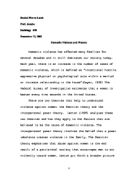Leading on from this, is evidence of massacres. These are largely identified by the way in which bodies are buried and the gender and age of the people buried there. Indications of a Neolithic massacre were discovered in 1983 in Talheim, Germany.
The remains of 34 people were discovered at this site; 16 children, 11 men and 7 women. Most of the adult males were in their early twenties and there were a few in their late 40’s. Most of the people had suffered violent deaths. Many had received blows to the head. A couple of the older men had been hit with arrows and spears. The bodies were then buried, in what would appear to be a hurried way (the bodies are all intact so they could not have been exposed for long) and then thrown into a pit. The manner of this burial shows that the people who killed this population had little, or no respect for them. A typical burial from this period would have usually contained grave goods that had been carefully arranged. All that this one contained was broken sherds of pot.
The massacre at Talheim was probably carried out by other farmers from the area, angered maybe over a land dispute, but sometimes archaeologists do find evidence to suggest that there were trained warriors during prehistoric times.
The idea of there being specialists in the field of fighting suggests that the prehistoric people expected violence, that violence and conflict were more commonplace than originally hypothesised.
Rock art (mainly from the south cost of Spain) is the key piece of evidence used to suggest that there were indeed warriors. At Cueva del Roure a painting shows four archers confronting three. At El Molino de las Fuentas 15 archers are shown confronting 20 on another side. Whilst rock art is incredibly hard to interpret, it is plain to see that this must represent battles. There is, however, some confusion over the date of the paintings. Some believe they are Mesolithic, others think Neolithic.
The presence of weapons in the archaeological record substantiates the theory of violence and conflict being fairly widespread during the prehistoric period.
Two bodies dating back to the late Palaeolithic have been found in Italy. One, from Sicily, was a woman with a flint point in her pelvis. The other, from mainland Italy, was the body of a child, with a flint point in its backbone. It isn’t certain whether the points are spear tips or arrowheads. It is most likely that they are arrowheads. Either way this is strong evidence for the presence of interpersonal violence in even the Palaeolithic.
A lot more weapons have been found for the Mesolithic. These include what have been interpreted as battle axes, daggers and arrowheads. Also a small number of wooden clubs have been found. These appear to have been used even more during the Neolithic. Skulls have been studied from the Neolithic and show injuries where the person had suffered a blow to the head from a blunt object.
Moving on into the Bronze Age swords were beginning to appear.
It has been acknowledged that these swords were probably used as more of a status symbol, rather than a weapon. However, Sue Bridgeford, an experimental archaeologist is trying to prove otherwise.
Some of the swords found have marks and striations all along the blade. These were originally believed to be due to the passage of time. However, Sue Bridgeford has designed a set up to show that the marks are due to combat. She has taken examples of the bronze used to make the swords, worked them to the same thickness and then, using a mechanical arm, hit the two pieces of bronze together (blade to blade). From her research she has discovered that the marks caused by the colliding of the two bronze blades, are consistent with those on the blades of the Bronze Age swords.
Sometimes, records dating back to the period of the Roman Invasion are found. These contain writings of how the Iron Age Britons would paint themselves blue with woad, and face their enemy naked. While this could be true, exaggerations on the part of the Roman scribe would not be uncommon. However, other, more remote, sources can be used as documentation of violence in prehistory.
The most prominent of such proto-histories is Homer’s Illiad. This Greek poet’s detailed account of an attack on the city of Troy provides archaeologists with a small insight into the style of fighting employed by prehistoric warriors. From the poem they have gained the understanding that trained warriors would have fought against each other, and that there was also a strong sense of territory and boundaries, perhaps even more so then, than now.
In conclusion, it would seem that there is a lot of evidence to indicate that warfare dates back a lot further than people would sometimes be lead to believe. Weapons have been found, paintings of warriors discovered, skeletons bearing terrible wounds unearthed and proto-histories providing documentation of prehistoric battles studied. However, no one can ever be certain as to what prehistoric warfare was truly like, but it is fairly certain that prehistory was not as peaceful as it was once portrayed.







